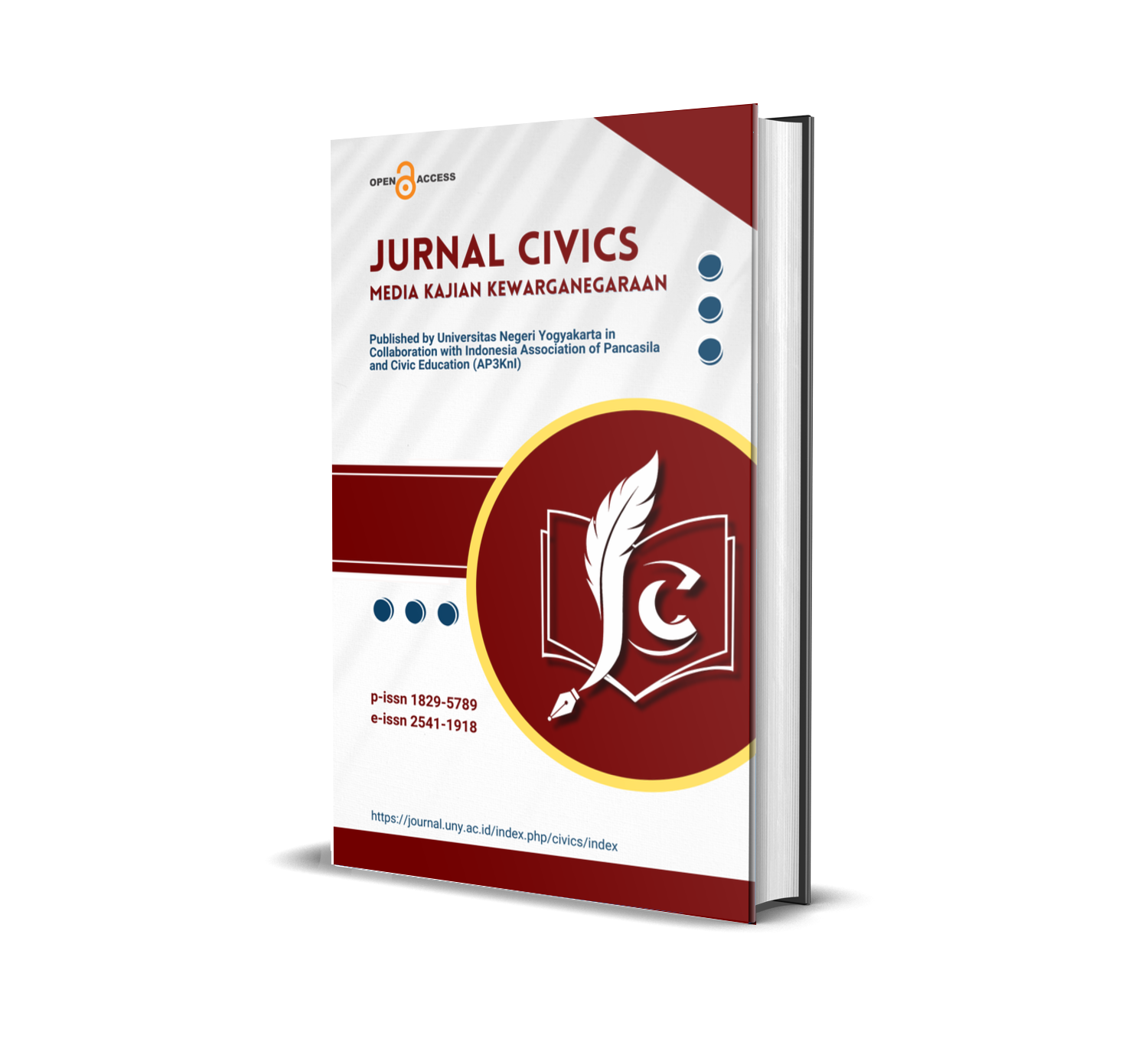Harmonization of Indonesia-Malaysia border communities based on socio-culture
DOI:
https://doi.org/10.21831/jc.v21i1.68478Keywords:
border region, border people, harmonization, Indonesia-Malaysia, socio-culturalAbstract
Harmonizing the border society between Indonesia and Malaysia based on their socio-cultural similarities presented an exciting exploration into the social and cultural dynamics that formed the relationship between these neighboring countries. This study explored the complex interactions of traditions, faiths, and practices that fostered cross-border unity and cooperation and highlighted the socio-cultural foundations that bind these communities together. The research was conducted in the border area between Indonesia and Malaysia, especially at Aruk Village, Sajingan Besar District, Sambas Regency. The method used in this research is phenomenology with the qualitative approach. The research findings indicated that the community at Aruk Village collectively managed the forests and natural resources. There were several cultural similarities among the Dayak Ethnic, Bidayu Sub-ethnic, and Melayu Ethnic who stayed in the Aruk Village area. This research highlighted local ideologies' role in strengthening social togetherness. Local wisdom, a binding force, was found to contribute significantly to the prosperity of the society, instilling a sense of optimism about the future of these communities. The harmonization of the border society between Indonesia and Malaysia showed the cognation of those residing in Aruk Village, Indonesia, with those residing in Serawak, Malaysia.
References
Arifin, S. (2014). Hukum perbatasan darat antarnegara. PT Sinar Grafika.
Arsana, I. M. A. (2018). Batas maritim antarnegara: sebuah tinjauan teknis dan yuridis. UGM Press.
Bangun, B. H. (2017). Konsepsi dan pengelolaan wilayah perbatasan negara: perspektif hukum internasional. Tanjungpura Law Journal, 1(1), 52-63. http://dx.doi.org/10.26418/tlj.v1i1.18331
Buzan, B., Wæver, O., & De Wilde, J. (1998). Security: A new framework for analysis. Lynne Rienner Publishers.
Diab, A. L., Pabbajah, M., Nurina Widyanti, R., Muthalib, L. M., & Fajar Widyatmoko, W. (2022). Accommodation of local wisdom in conflict resolution of Indonesia’s urban society. Cogent Social Sciences, 8(1), 2153413. https://doi.org/10.1080/23311886.2022.2153413
Hadiwijoyo, S, S. (2008). Batas wilayah negara Indonesia dimensi, permasalahan dan strategi penanganan. PT Gava Media.
Hamzani, A. I., et al (2023). Non-procedural dispute resolution: study of the restorative justice approach tradition in indonesian society. International Journal of Offender Therapy and Comparative Criminology, 0(0). https://doi.org/10.1177/0306624X231165425
Hylland-Eriksen, T. (2011). What is a society?. Ethnicities, 11(1), 18-22. https://doi.org/10.1177/14687968110110010203
Jongsuksomsakul, P. (2024). Culinary storytelling about the local cuisine of Phitsanulok, Thailand. Sage Open, 14(1). https://doi.org/10.1177/21582440241233451
Kadarisman, M. (2010). Faktor geografi dalam mencegah disintegrasi bangsa (upaya mempertahankan nasionalisme Indonesia). Sociae Polites, 11(30), 39–52.
León, M., Jiménez, M., Vidal, N., Bermúdez, K., & De Vos, P. (2020). The role of social movements in strengthening health systems: The experience of the National Health Forum in El Salvador (2009–2018). International Journal of Health Services, 50(2), 218-233. https://doi.org/10.1177/0020731420905262
Little, A. (2015). The complex temporality of borders: Contingency and normativity. European Journal of Political Theory, 14(4), 429-447. https://doi.org/10.1177/1474885115584831
Manchanda, N. (2017). Rendering Afghanistan legible: Borders, frontiers and the ‘state’ of Afghanistan. Politics, 37(4), 386-401. https://doi.org/10.1177/0263395717716013
Martinez, O. J. (1994). Border people: Life and society in the US-Mexico borderlands. University of Arizona Press.
Miller, L. L. (2023). Checks and balances, veto exceptionalism, and constitutional folk wisdom: class and race power in American politics. Political Research Quarterly, 76(4), 1604-1618. https://doi.org/10.1177/10659129231166040
O'Dowd, L. (2010). From a ‘borderless world’to a ‘world of borders’:‘bringing history back in’. Environment and Planning D: Society and Space, 28(6), 1031-1050.
Opioła, W. (2014). About the role of the state border in the theory of borderland. In: W. Chlebda (ed.), Open Europe: Cultural Dialogue across Borders. Vol. 2: Historical Collective Memory within Borderlands. Opole: Wydawnictwo Uniwersytetu Opolskiego, pp. 27-35.
Parashar, A., et al (2023). Creating awareness for sustainable goals: reading ruskin bond’s short stories through bioregionalism lenses. IIM Kozhikode Society & Management Review, 0(0). https://doi.org/10.1177/22779752231204194
Perkowski, N., et al (2023). The evolution of EUropean border governance through crisis: Frontex and the interplay of protracted and acute crisis narratives. Environment and Planning D: Society and Space, 41(1), 110-129. https://doi.org/10.1177/02637758231152478
Prokkola, E. K. (2011). Cross-border regionalization, the INTERREG III A initiative, and local cooperation at the Finnish-Swedish border. Environment and planning A, 43(5), 1190-1208. https://doi.org/10.1068/a43433
Samiyono, D. (2017). Membangun harmoni sosial: kajian sosiologi agama tentang kearifan lokal sebagai modal dasar harmoni sosial. JSW (Jurnal Sosiologi Walisongo), 1(2), 195-206. https://doi.org/10.21580/jsw.2017.1.2.1994
Scott, J. W. (2013). Borders and social ordering: Critical reflections on border-making. Dialogues in Human Geography, 3(1), 120-122. https://doi.org/10.1177/2043820613487971
Shields, P. (2014). Borders as information flows and transnational networks. Global Media and Communication, 10(1), 3-33. https://doi.org/10.1177/1742766513513195
Šmidrkal, V. (2017). They Shall—or Shall Not—Pass? Communist State Borders in the Czech Culture of Remembrance after 1989. East European Politics and Societies, 31(2), 251-268. https://doi.org/10.1177/0888325416679693
Suwartiningsih, S., & Purnomo, D. (2020). Harmoni Sosial Berbasis Kearifan Lokal “Doa Arwah” pada Masyarakat Perbatasan Indonesia-Timor Leste Social Harmonisation Based on Local Wisdom of “Doa Arwah” in Indonesia-Timor Leste Border Community. Anthropos, 5(2), 170-182. https://doi.org/10.24114/antro.v5i2.15132
Wang, F., Xue, P., Su, W., & Hu, X. (2024). The locality-adaptation theory of traditional villages. Indoor and Built Environment, 1420326X241234171. https://doi.org/10.1177/1420326X241234171
Yu, L., & Xu, W. (2022). Institutional conformity, entrepreneurial governance and local contingency: problematizing central-local dynamics in localizing china's low-income housing policy. Environment and Planning A: Economy and Space, 54(3), 508-532. https://doi.org/10.1177/0308518X211061400
Downloads
Published
How to Cite
Issue
Section
Citation Check
License
This work is licensed under a Creative Commons Attribution-NonCommercial-ShareAlike 4.0 International License.
The authors agree to transfer the transfer copyright of the article to The Jurnal Civics: Media Kajian Kewarganegaraan effective if and when the paper is accepted for publication.
Authors and other parties are bound to the Creative Commons Attribution-NonCommercial-ShareAlike 4.0 International License for the published articles, legal formal aspect of journal publication accessibility refers to Creative Commons Attribution-NonCommercial-ShareAlike 4.0 International License (CC BY-NC-SA).










